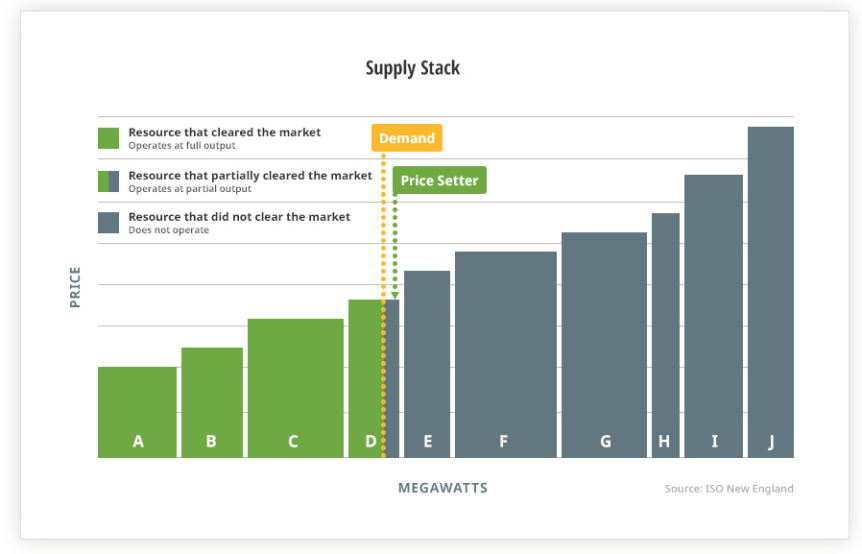Electricity that is not available as and when consumers need it has no natural commercial value.
An ICU patient on life support isn’t interested in whether the weather is going to keep her alive. For that reason, chaotically delivered wind and solar just don’t add up. The only thing that adds up are massive (and seemingly endless) subsidies; whether they be in the form of Production Tax Credits, Renewable Energy Certificates, soft loans, minimum prices guaranteed by government contracts or straight out cash grants.
Remove the subsidies and the wind and solar industries will disappear in a heartbeat.
How those subsidies affect (read ‘distort’ and ‘pervert’) the electricity market is the subject of Donn Dears analysis below.
Fixing the Rigged Market for Electricity
Power for USA
Don Dears
30 July 2019
The simplest and best way to fix the rigged market for electricity is to return to the regulated market system still used by one-third of the country. See, The Market for Electricity is Rigged
Assuming, for a moment, this isn’t possible, several steps will be required to fix the market for electricity, but a simple first step would be to pay the bidders their bid price.
Everyday, each RTO/ISO conducts a day-ahead auction where each bidder submits its lowest offering price for every five minute increment of the day.
Here is a chart from the New England Independent System Operator’s website.

Let’s make the following assumptions.
Bidders A, B and C are from wind and PV Solar suppliers, while bidder D is a natural gas combined cycle (NGCC) supplier.
Wind and PV solar suppliers receive other payments or grants to cover their costs and can, as a result, bid as low as $0, though they may bid somewhat more.
Because of this, wind and PV solar are always the winning bidders as long as wind or solar is available. For example, if the sun isn’t forecast to shine there may not be a PV solar bidder.
Bidder D, in this example, is the marginal resource or price setter.
Typically, when there are no more wind or PV solar bidders, the next bid will be from an NGCC supplier because their costs are usually lower than bids from nuclear power plants.
Let’s assume Bidder D bids 6 cents per kWh.
As ISO NE notes on its website, D is the price setter and gets paid 6 cents per kWh for the electricity they produce.
But, bidders A, B, and C also get paid 6 cents per kWh.
Why are they being paid more than they bid?
Wind and PV solar providers merely need to be sure they bid below whatever any other supplier bids to guarantee they still get paid whatever the marginal resource or price setter bids.
And they can nearly always bid lower because they have other sources of income.
Wind for example, gets paid the production tax credit of 2.3 cents per kWh for every kWh they produce. They just need to be sure to win the bid so they can generate the electricity for which they get the 2.3 cent per kWh subsidy.
Paying bidders what they actually bid would help level the playing field.
Currently, the bidding system is a sham, even though the bidding process, known as a uniform clearing price auction, is common in auctions involving commodities.
However, this type of auction isn’t suitable for the electricity market.
A true commodity, such as wheat, is identical whether its grown in Iowa or Nebraska.
The problem with attempting to use this type of auction in the electricity market is that electricity from wind and solar isn’t available 24/7.
The bushel of wheat is available 24/7.
While seemingly subtle, the difference is huge.
A natural gas combined cycle or nuclear power plant can guarantee electricity is available 24/7.
It’s impossible for electricity from wind and solar to be available 24/7, unless sufficient storage is available to store enough electricity generated by wind or solar to make it available 24/7 … And that cost is huge and not included in the auction. See, Four Minutes for $150 million, for a discussion of storage.
The RTO/ISO’s are very opaque with the information they provide about the auction system, including obfuscations that impede understanding how the system works. See, From the Horse’s Mouth
Other writers who have written on RTO/ISO auctions include Meredith Angwin and Willam Post.
- I’m waiting for Meredith Angwin’s new book, Shorting the Grid, that should be out later this year as it will provide considerable information on this subject.
- Today’s article used information from William Post’s article “How Resources Are Selected And Prices Are Set In The Wholesale Electricity Markets.”
Summary
The type of auctions used by RTO/ISOs for determining whose electricity to purchase for use on the grid is not suited for the electricity market.
The process is rigged in favor of wind and solar even though they are unreliable and incapable of guaranteeing the availability of electricity 24/7.
The market is not competitive.
The uniform clearing price auction system is destroying the market for nuclear power and is unfairly rewarding wind and solar in preference to other methods that can guarantee the availability of electricity 24/7.
Power for USA



Whoever dreamed up this systematized racket was very clever. It has the appearance of being a ‘market’ for electricity but as the author points out, it is easily (and continuously) rigged, with the aid of the ‘renewables only’ subsidy, from the get go. We have the same system in Australia, but instead of the tax credit we have another hidden subsidy that forces energy retailers to buy 30% of their demand from ‘renewables’ generators, and also buy ‘clean energy’ certificates from the same generator or pay an AUD$65.00/MWh penalty to the federal government. This equates to a subsidy for renewables worth between 50-100% of the wholesale price of electricity. So our renewable generators can easily sell their output for $0 or even less and still make a profit! No wonder our base load generators are going broke.
Precisely.
Ziggy Switkowski more well known for transferring taxpayer money into private pockets al la Telstra reduced to contractors, than his nuclear understanding (outdated?) – the slight of hand of seemingly lowering government/taxpayer funding while he jet-sets around the world – is there a possible Blood & Gore connection of carbon trading? As he now says we’ve missed the large plant nuclear energy boat – see Government Inquiry.
So it’s admirable that dispersed small nuclear plants; like in warships, gets his tick of approval. Portable, inter connectable, able to be isolated in case of sectional failure, with a small footprint and heaven forbid, such a minor contamination area.
The pseudo-scare tactics even ignored that during Hurricane Katrina the New Orleans underground nuclear plant kept operating without problems: Maybe he should put his analytics toward the beautiful city of Flint, Michigan. As under PM John Howard he kept flying to USA for his assumed financial interests.
But overall we of the pro nuclear (apart from bombs and other nasties) salute the implied suggestion that dispersal of small portable units able to be relocated where necessary – a concept inherent in military defence – is fantastic.
Then to incorporate the independent diversity of wind and solar, ignore its unreliable disparity of union in a hotchpotch of complicated unison and backup reliability, to use a singularity of reliable productivity is highly admirable.
But no more money Ziggy; it’s your contribution to the welfare and betterment of humanity and society – well maybe just an AO gong.
thx another very informative post making a mockery of the clean energy industry and the real harm they do to our grid. I wish the angus taylor’s of this world would read your site!
Reblogged this on ajmarciniak.
Reblogged this on Climate- Science.press.